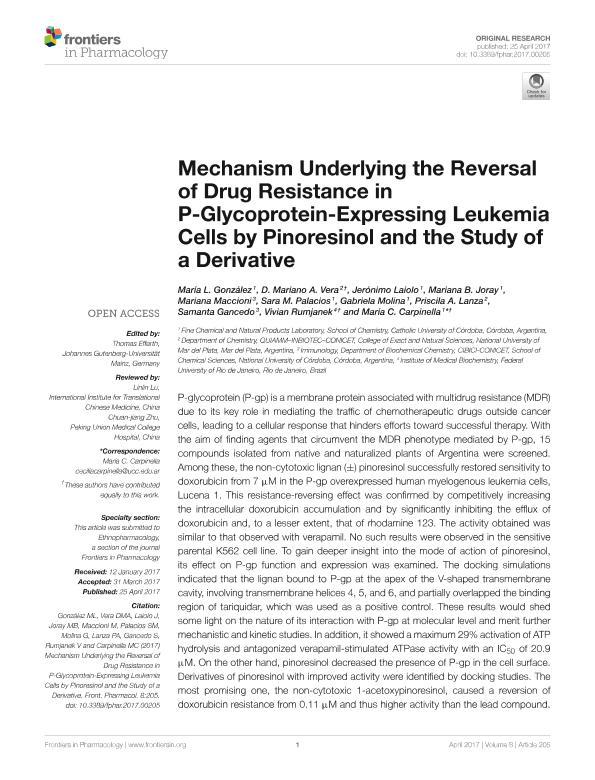Artículo
Mechanism Underlying the Reversal of Drug Resistance in P-Glycoprotein-Expressing Leukemia Cells by Pinoresinol and the Study of a Derivative
González, María Laura; Vera, Domingo Mariano Adolfo ; Laiolo, Jerónimo
; Laiolo, Jerónimo ; Joray, Mariana Belén
; Joray, Mariana Belén ; Maccioni, Mariana
; Maccioni, Mariana ; Palacios, Sara Maria
; Palacios, Sara Maria ; Molina, Gabriela; Lanza Castronuovo, Priscila Ailin
; Molina, Gabriela; Lanza Castronuovo, Priscila Ailin ; Gancedo, Samanta; Rumjanek, Vivian; Carpinella, Maria Cecilia
; Gancedo, Samanta; Rumjanek, Vivian; Carpinella, Maria Cecilia
 ; Laiolo, Jerónimo
; Laiolo, Jerónimo ; Joray, Mariana Belén
; Joray, Mariana Belén ; Maccioni, Mariana
; Maccioni, Mariana ; Palacios, Sara Maria
; Palacios, Sara Maria ; Molina, Gabriela; Lanza Castronuovo, Priscila Ailin
; Molina, Gabriela; Lanza Castronuovo, Priscila Ailin ; Gancedo, Samanta; Rumjanek, Vivian; Carpinella, Maria Cecilia
; Gancedo, Samanta; Rumjanek, Vivian; Carpinella, Maria Cecilia
Fecha de publicación:
04/2017
Editorial:
Frontiers
Revista:
Frontiers in Pharmacology
e-ISSN:
1663-9812
Idioma:
Inglés
Tipo de recurso:
Artículo publicado
Clasificación temática:
Resumen
P-glycoprotein (P-gp) is a membrane protein associated with multidrug resistance (MDR) due to its key role in mediating the traffic of chemotherapeutic drugs outside cancer cells, leading to a cellular response that hinders efforts toward successful therapy. With the aim of finding agents that circumvent the MDR phenotype mediated by P-gp, 15 compounds isolated from native and naturalized plants of Argentina were screened. Among these, the non-cytotoxic lignan (±) pinoresinol successfully restored sensitivity to doxorubicin from 7 μM in the P-gp overexpressed human myelogenous leukemia cells, Lucena 1. This resistance-reversing effect was confirmed by competitively increasing the intracellular doxorubicin accumulation and by significantly inhibiting the efflux of doxorubicin and, to a lesser extent, that of rhodamine 123. The activity obtained was similar to that observed with verapamil. No such results were observed in the sensitive parental K562 cell line. To gain deeper insight into the mode of action of pinoresinol, its effect on P-gp function and expression was examined. The docking simulations indicated that the lignan bound to P-gp at the apex of the V-shaped transmembrane cavity, involving transmembrane helices 4, 5, and 6, and partially overlapped the binding region of tariquidar, which was used as a positive control. These results would shed some light on the nature of its interaction with P-gp at molecular level and merit further mechanistic and kinetic studies. In addition, it showed a maximum 29% activation of ATP hydrolysis and antagonized verapamil-stimulated ATPase activity with an IC50 of 20.9 μM. On the other hand, pinoresinol decreased the presence of P-gp in the cell surface. Derivatives of pinoresinol with improved activity were identified by docking studies. The most promising one, the non-cytotoxic 1-acetoxypinoresinol, caused a reversion of doxorubicin resistance from 0.11 μM and thus higher activity than the lead compound. It also caused a significant increase in doxorubicin accumulation. Results were similar to those observed with verapamil. The results obtained positioned these compounds as potential candidates for effective agents to overcome P-gp-mediated MDR, leading to better outcomes for leukemia chemotherapy.
Archivos asociados
Licencia
Identificadores
Colecciones
Articulos(CCT - CORDOBA)
Articulos de CTRO.CIENTIFICO TECNOL.CONICET - CORDOBA
Articulos de CTRO.CIENTIFICO TECNOL.CONICET - CORDOBA
Articulos(CIBICI)
Articulos de CENTRO DE INV.EN BIOQUI.CLINICA E INMUNOLOGIA
Articulos de CENTRO DE INV.EN BIOQUI.CLINICA E INMUNOLOGIA
Articulos(INBIOTEC)
Articulos de INSTITUTO DE INV. EN BIODIVERSIDAD Y BIOTECNOLOGIA
Articulos de INSTITUTO DE INV. EN BIODIVERSIDAD Y BIOTECNOLOGIA
Articulos(IRNASUS)
Articulos de INSTITUTO DE INVESTIGACIONES EN RECURSOS NATURALES Y SUSTENTABILIDAD JOSE SANCHEZ LABRADOR S.J.
Articulos de INSTITUTO DE INVESTIGACIONES EN RECURSOS NATURALES Y SUSTENTABILIDAD JOSE SANCHEZ LABRADOR S.J.
Citación
González, María Laura; Vera, Domingo Mariano Adolfo; Laiolo, Jerónimo; Joray, Mariana Belén; Maccioni, Mariana; et al.; Mechanism Underlying the Reversal of Drug Resistance in P-Glycoprotein-Expressing Leukemia Cells by Pinoresinol and the Study of a Derivative; Frontiers; Frontiers in Pharmacology; 8; 4-2017; 1-19; 205
Compartir
Altmétricas



